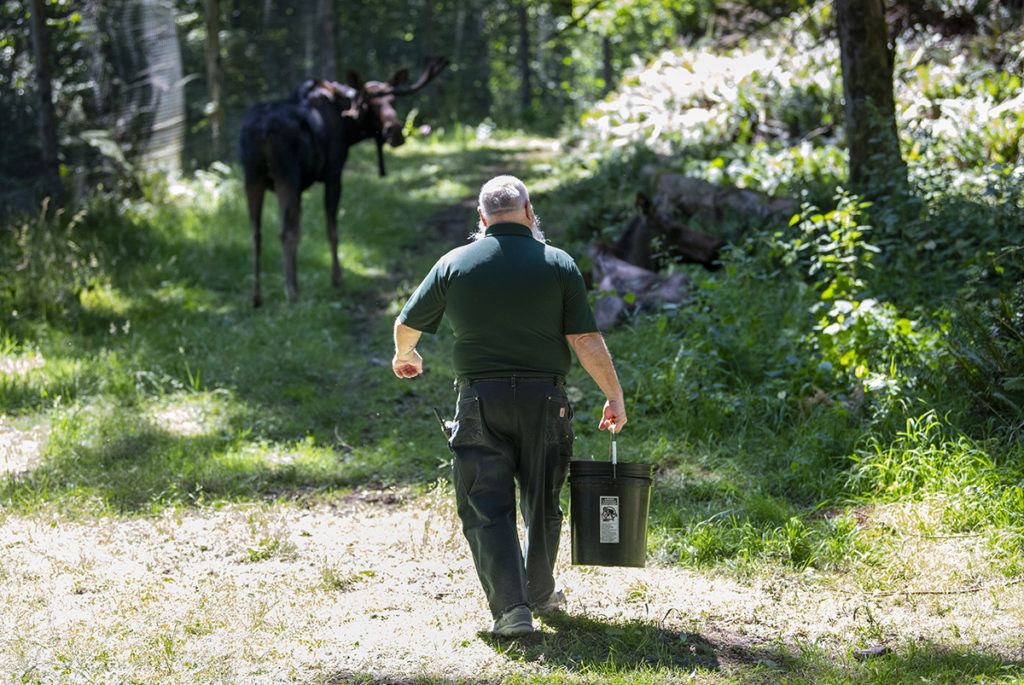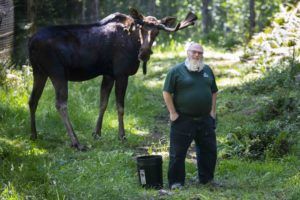
It’s 11am, and Ed Cleveland is hoisting 50-pound bags of bear chow into a small storage shed. In a mask. On an 80-degree day. As he catches his breath, he jokes with fellow keeper Deanna Edwards, who’s restocking the keeper truck for a midday feed. Then he takes a long, assessing look at stock levels and heads back to the office to book in a major delivery.
For Cleveland, a 62-year-old with a long Santa Claus beard and quiet smile, it’s just one part of being head keeper at Northwest Trek – a place he’s worked at for 36 years, and from where he’s soon to retire.
“Making sure we have food, and making sure we have staff,” Cleveland sums up, at a corner desk with moose antlers resting behind his head. “That’s my job.”
It’s a huge job, one that entails everything from spreadsheets to spending time with moose, Cleveland’s not-so-secret favorite animal. From 7:30am to 4pm each day, Northwest Trek’s head keeper has to make sure everyone gets fed, and everyone knows their schedule. And if there’s a gap, he’ll fill it.
“There is no average day,” he says.
Food and Supplies
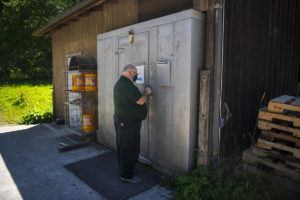
Northwest Trek cares for around 185 animals, and they go through a vast amount of food each day. But the sheds to store that food? Just two of them, about the size of a small garage, plus a walk-in freezer. So it’s up to Cleveland to juggle all the different specialty diets and make sure there’s always enough of each.
“I pick up the smaller orders locally, like the bear chow,” says Cleveland. “But the big orders like the herbivore pellets that feed all our Free-Roaming Area animals come on a flat-bed truck every three weeks.”
When the truck arrives, Cleveland and his fellow keepers unload the pallets by hand – about 240 bags each weighing 50 pounds ¬– in rain, shine or snow.
As he’s explaining, Wetlands keeper Miranda Mauck arrives to pick up the midday feed from the walk-in freezer that holds prey and fresh meat.
“I just got extra frozen mice, rabbits and quail in there for you,” Cleveland says.
“Ooh, good!” smiles Mauck.
Keeping Keepers Organized
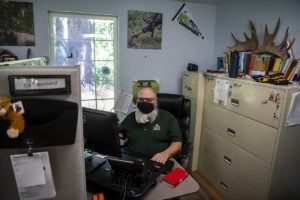
Creating the complex schedule of keeper care is another of Cleveland’s jobs, juggling skills, holidays, weekends, vacations, early and late shifts, sick days and individual animal needs in a way that resembles a school timetable.
But in the early days, things were a little different.
“When I arrived here 36 years ago, we had two keepers,” remembers Cleveland, who landed the job after two years as a state wildlife biologist aide in Idaho and another two as a keeper at the busy St. Louis Zoo. “I was one of them.”
Over its 45-year history, Northwest Trek grew from a small donated property to a wildlife park with multiple animal habitats and experiences. Much of that was under Cleveland’s watch. There are now nine full-time and four part-time keeper staff, and many more animals.
“I always tell people Northwest Trek is halfway between a wildlife area and a big zoo – and I really like that combination,” Cleveland says. “We’ve grown so much: more enrichment for the animals, longer opening hours – we used to be completely closed between October and March. And more sophisticated animal care – we do so many veterinary procedures out in the Free-Roaming Area now, instead of transporting them to the animal care clinic, which is better for the animals.”
As well as managing schedules, Cleveland manages the daily animal reports that keep a record of animal health and care. He runs staff meetings, and makes sure everyone’s in the loop about what’s going on, connecting keepers with animal curator Marc Heinzman and veterinary staff.
Projects and People
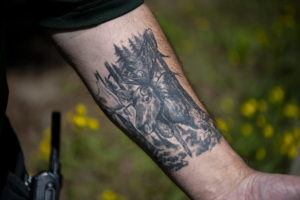
As if that weren’t enough, Cleveland fills any empty spots in his day by helping out. He joins in with building projects like new moose feeders, fills in staffing Wild Drive tours when needed and assists with Free-Roaming Area keeper duties.
He’s looking forward to doing more home projects when he retires, plus plenty of fishing, cooking and reading (“I love a good book,” he says). But he’ll really miss the animals – and the people.
“I love moose,” he says, simply. “I first saw one on my first day working in Idaho, and I fell in love with them. I’ve gotten so close to all our moose here – I try not to pick favorites, but I do. They come right up to you, when you feed them.”
And after years of thinking about it, Cleveland recently got his first tattoo – a soft-nosed moose, surrounded by forest, on his burly left forearm.
“But I also love caribou – so maybe I’ll have to get another tattoo on my right arm!” he jokes.
Most of all, it’s the people he’ll miss at Northwest Trek.
“Coming from a big zoo like St. Louis, what I really liked was being able to get to know everyone here personally, from maintenance to animal care to administration,” he says. “That’s been so good. I’ll miss everyone a lot.”
It’s About Native Wildlife
So how did a St. Louis boy whose grandma taught him to love birdwatching end up spending most of his career as a Northwest Trek keeper?
“I love native American animals,” he says, simply. “That’s the most important part of my job. I got to meet the founders of this place, “Doc” and Connie Hellyer, and I feel like I’m carrying on their mission of conserving Northwest wildlife and helping others do the same.”
